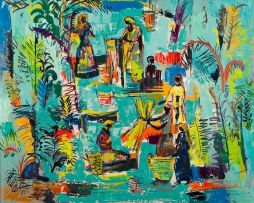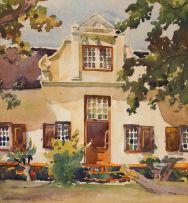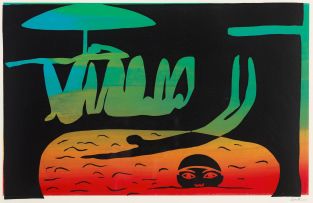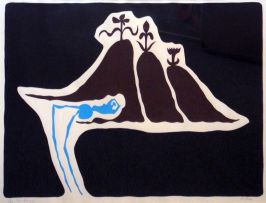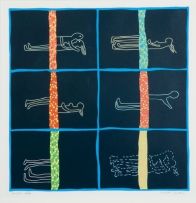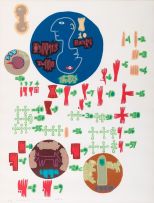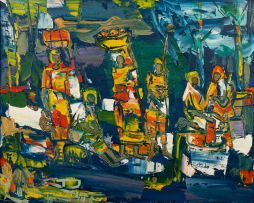South African and International Art
Live Auction, 12 November 2012
Evening Sale
Incl. Buyer's Premium & VAT
About this Item
signed; signed on the reverse
Notes
"Some artists learn by copying the old masters in museums. Walter Battiss did his apprenticeship in caves, on the rock face. And what the Bushmen taught him, he applied," states Andrew Verster in his essay on Battiss.1
Walter Battiss' interest in rock art began in 1917 when the Battiss family moved from Somerset East to Koffiefontein. The young Battiss' imagination was fired during excursions into the surrounding countryside where he came across the many rock-painting sites dotted around the area. This amateur enthusiasm persisted after he moved to Johannesburg (later Pretoria) and proved pivotal in his decision to change career paths. 2
These early discoveries saw Battiss develop a unique pictorial language of calligraphic forms describing figures and foliage that he engaged in his paintings. He side-stepped the traditional approach to perspective in his paintings by negating the requisite creation of a three-dimensional space within the constraints of a two-dimensional medium. The vignettes of women at various pursuits are united overall by their inclusion in the composition - each figure busies herself with daily tasks such as basket weaving or grinding corn. These every day undertakings equate the spiritual essence of the same rock surface Battiss studied in the caves.
In the foreword of the catalogue that accompanied the exhibition curated for the Pretoria Centenary celebration in September 1955, Maria Stein-Lessing states:
"Art proper in South Africa starts only at the beginning of the 20th century…The formal and abstract idiom of Modern Art in Europe was gradually adopted by our artists, and in the case of Battiss […] a new South African modern idiom arose."
1 Skawran, K. and Macnamara, M. (ed), Walter Battiss, AD Donker (Pty) Ltd, Johannesburg, 1985, page 169.
2 Berman, Esmé, The Story of South African Painting, A.A. Balkema, Cape Town, 1975, page 131.
Provenance
The late J. Wickens, Pretoria.
Exhibited
Rhodes Centenary Exhibition, Bulawayo, 1953.
Southern African Association of Arts (Transvaal) for the Pretoria Centenary, Pretoria, Historical Exhibition of South African Art, 13-30 September 1955, illustrated in the catalogue.

